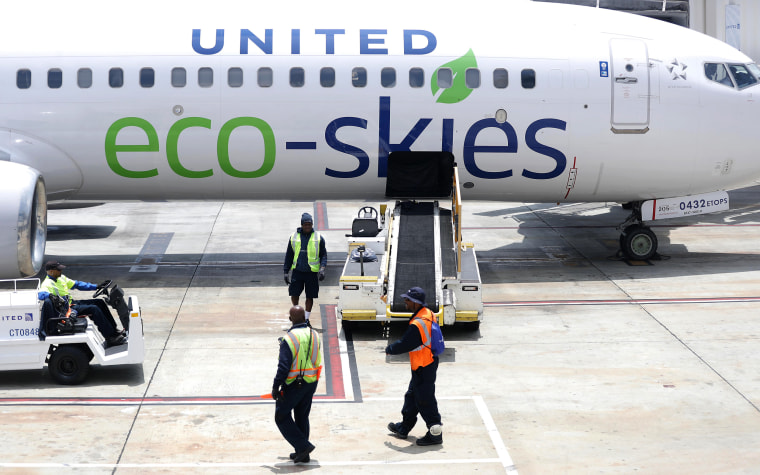The average American generates around 1 ton of carbon pollution powering every lightbulb, phone, television, computer and kitchen appliance in their home for two months. But a single round-trip flight from New York to London is all it takes to generate that same amount of carbon pollution, a fact that has left some jetsetters feeling “flight shame,” and a growing number of others even forgoing air travel.
The airline industry has expressed concern that flight shame will put a dent in their bottom line, and they are taking steps to use less fuel — packing more passengers into fewer flights, for instance, or using high-tech navigation systems to make sure planes take the shortest route to their destination.
These changes will help curb pollution, experts say, but the best way to clean up planes is to switch to fuel made from plants.
“Biofuels are what’s going to save us when it comes to aviation,” said Corinne Scown, a scientist and engineer at the Joint BioEnergy Institute at the Lawrence Berkeley National Laboratory in Emeryville, California. “There just aren’t a lot of other good options.”
Commercial aircraft run on kerosene-based fuel, but it is possible to make jet fuel from vegetable oil, algae, rotting fruit — even used diapers. Biofuels could cut carbon pollution from airplanes by upwards of 60 percent, potentially helping them pollute as little as buses and trains.
Several airlines, including United Airlines, American Airlines, Virgin Atlantic and Air France, already power airplanes with a blend of conventional fuel and biofuel, though biofuels only account for a tiny part of the mix. That's because biofuels are currently very costly — “approximately two to three times as expensive as conventional jet fuel," a spokesperson for the Dutch airline KLM said.
Costs will fall as airlines buy more biofuel, spurring suppliers to build more refineries near major airports, creating a pipeline for cheaper plant-based fuel. Before that happens, however, suppliers will need to secure a steady supply of raw material.
Currently, many airlines, including KLM, use biofuel made from used cooking oil. While used cooking oil is cheap and relatively easy to refine, “there is a relatively limited amount of that compared to what the need is," Jim McMillan, chief engineer at the National Bioenergy Center in Golden, Colorado, said. In other words, as much as people love French fries, they don't eat enough of them to sustain commercial air travel with the leftover grease.
To solve this problem, biofuel suppliers are starting to make fuel from cheap, abundant organic waste. That could mean waste from farms, such as corn leaves, wheat stalks and almond hulls. Or it could mean trash found in city dumps, such as paper, cardboard and leftover food.
“There are [biofuel] companies that are taking in municipal solid waste, for example, and getting paid to take it in,” McMillan said.
United Airlines, which has previously used biofuel made from cooking oil, aims to power some of its planes with a blend that is one-half conventional fuel and one-half fuel made from "household trash," Aaron Robinson, the senior manager for environmental strategy and sustainability at United Airlines, told NBC News MACH in an email.
In addition to making fuel from food, suppliers could also turn forest debris into biofuel. In California, officials are setting controlled fires to burn the dry underbrush that leaves forests susceptible to wildfires. Rather than burn that underbrush, they could use the dead timber to power planes, Scown, of the Joint BioEnergy Institute, said.
Still, biofuels aren’t a perfect solution. Some biofuels are made in refineries powered by coal, or shipped in gas-powered trucks. Overall, though, they are a more climate-friendly option than conventional fuel, and they offer a way to turn organic waste — which would otherwise decompose into methane, a powerful heat-trapping gas — into something useful.
Biofuels also have a big advantage over electric planes, another option for more sustainable air travel. While biofuels can still perform in frigid temperatures at high altitudes, “battery technologies don't do very well at very, very low temperatures,” Scown said. Batteries are also very heavy.
“You can't store the amount of energy that you need in a format that is affordable or liftable to go any significant distance,” said Blake Simmons, chief science and technology officer at the Joint BioEnergy Institute. “And I’m not going to get on a plane with an extension cord,” he joked.
Simmons said battery technology may improve to the point where they can be used on commercial aircraft, but progress will likely be measured in decades, not years.
That's not the case with biofuels. In three to seven years, he said, passengers could board flights that are powered by a blend that is 50 percent biofuels. And in 10 to 15 years, airlines may be flying planes that are powered entirely by biofuels.
“I suspect you’ll be able to do a demonstration flight at a really high blend in the fairly near term, but [airlines] operate on such thin profit margins that it will be a little bit longer before they can do that for all of their commercial flights,” Scown said.
“Our vision is that every time you get on a plane that’s fueled with a biofuel, you are not only not emitting fossil carbon, but you are diverting organics from a landfill or helping to avoid unnecessary wildfires,” she added. “That’s a few years out, but that’s where I ultimately would like to see us go. And then you hopefully shouldn’t have any plane shame.”
Want more stories about the environment?
- Deep inside Earth, scientists find weird blobs and mountains taller than Mount Everest
- Immense crater may have been found deep under Greenland's ice sheet
- This floating city concept is one way to cope with climate change
SIGN UP FOR THE MACH NEWSLETTER AND FOLLOW NBC NEWS MACH ON TWITTER, FACEBOOK, AND INSTAGRAM.

